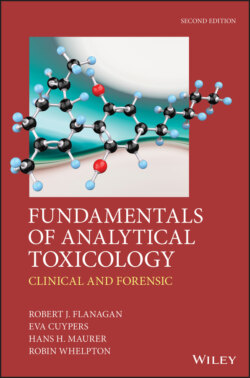Читать книгу Fundamentals of Analytical Toxicology - Robin Whelpton - Страница 77
Box 2.4 Chain of custody documents
ОглавлениеName of the individual collecting the specimen(s)
Name of each person or entity subsequently having custody of it, and details of how it has been stored
Date(s) the specimen(s) collected or transferred
Specimen or post-mortem number(s)
Name of the subject or deceased
Brief description of the specimen(s)
Record of the condition of tamper-evident seals
Fully validated assays must include data on the stability of the analyte under specified sample collection and storage conditions (van de Merbel et al., 2014; Reed, 2016). In the absence of other information, biological specimens should be stored at 2–8 °C prior to analysis, if possible, and ideally any specimen remaining after the analysis should be kept at 2–8 °C for 3–4 weeks in case further analyses are required. In view of the medico-legal implications of some poison cases (for example, if it is not clear either how the poison was administered, or if the patient dies) then any specimen remaining should be kept (preferably at –20 °C) until investigation of the incident is concluded. Unfortunately, there are few stability data for whole blood specimens, let alone for post-mortem specimens.
Table 2.9 Some drugs, metabolites, and other poisons unstable in whole blood or plasma (data from Peters, 2007 and from Mata, 2016)
| Volatile agents | Aerosol propellants, anaesthetic gases, carbon monoxide, cyanide, ethanol, ethchlorvynol, mercury, methanol, nicotine, organic solvents, paraldehyde, volatile nitrites (amyl nitrite, etc.) |
| Non-volatile substances | Acyl (ester) glucuronides, amiodarone, aspirin, bupropion, carbamate esters (e.g. physostigmine, pyridostigmine), ciclosporin,a cyanide, esters (e.g. 6-AM, benzocaine, cocaine, diltiazem, diamorphine, GHB, pethidine, methylphenidate, procaine, succinylcholine), N-glucuronides (e.g. olanzapine N-glucuronide), insulins, insulin C-peptide, LSD, nitrobenzodiazepines (clonazepam, flunitrazepam, loprazolam, nitrazepam and their 7-amino metabolites), glyceryl trinitrate and other nitrates and nitrites, nitrophenylpyridines (e.g. nifedipine, nisoldipine), olanzapine, N-oxide metabolites, S-oxide metabolites, paracetamol, peroxides and other strong oxidizing agents, phenelzine, phenothiazines,b piperazines, proinsulin, quinol metabolites (e.g. 4-hydroxypropranolol), rifampicin, sirolimus,a N-sulfate metabolites (e.g. minoxidil N-sulfate), tacrolimus,a thalidomide, thiol-containing drugs (e.g. captopril), thiopental, zopiclone |
aRedistributes between plasma and erythrocytes on standing (use whole blood)
bParticularly those without an electronegative substituent at the 2-position
With regard to drugs, some compounds such as clonazepam, cocaine, nifedipine, nitrazepam, thiol drugs, and many phenothiazines and their metabolites are unstable in biological samples at room temperature (Table 2.9). Synthetic piperazines, for example, are generally unstable in whole blood, for example (Lau et al., 2018). Exposure to sunlight can cause up to 99 % loss of clonazepam in serum after 1 h at room temperature. Covering the outside of the sample tube in aluminium foil is a simple precaution in such cases. N-Glucuronides such as olanzapine N-glucuronide are unstable and may be present in plasma at high concentration; on decomposition the parent compound is reformed. Some compounds, notably olanzapine, appear relatively stable in plasma, but are dramatically unstable in haemolyzed blood.
Solid sodium fluoride may be added to at least partially inhibit microbial and some other degradative enzymes as discussed above (Section 2.3). Esters (including carbamates and organophosphates) may be rapidly hydrolyzed by plasma esterases, including cholinesterase. If physostigmine or cocaine are to be measured accurately the blood should be drawn into tubes containing an excess of neostigmine. Storage at –20 °C or below is recommended if the analysis cannot be performed immediately and if the stability of the analyte is unknown. However, even this may not be ideal because N- and S-oxides may be reduced to the parent compounds. Quinols such as 4-hydroxypropranolol, on the other hand, are readily oxidized.
Stabilization by addition of a reducing agent such as ascorbate or sodium metabisulfite has been advocated in some cases (Sørensen & Hasselstrøm, 2019), but is not performed routinely and in the case of olanzapine, for example, there is the possibility of reducing the N-oxide by such an addition. The monographs in the compendium by Baselt (2020) detail such stability data as there are for many compounds.
Storage at −5 to −70 °C should be accompanied by basic precautions to preserve sample integrity (Box 2.5). The requirements of the local ethics committee on the retention, storage, and safe disposal of clinical samples must be complied with.
